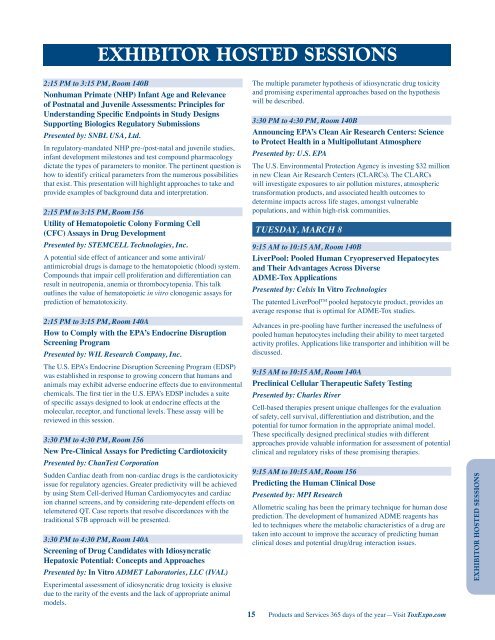Annual Meeting & ToxExpo Annual Meeting & ToxExpo Annual ...
Annual Meeting & ToxExpo Annual Meeting & ToxExpo Annual ...
Annual Meeting & ToxExpo Annual Meeting & ToxExpo Annual ...
You also want an ePaper? Increase the reach of your titles
YUMPU automatically turns print PDFs into web optimized ePapers that Google loves.
EXHIBITOR HOSTED SESSIONS<br />
2:15 PM to 3:15 PM, Room 140B<br />
Nonhuman Primate (NHP) Infant Age and Relevance<br />
of Postnatal and Juvenile Assessments: Principles for<br />
Understanding Specific Endpoints in Study Designs<br />
Supporting Biologics Regulatory Submissions<br />
Presented by: SNBL USA, Ltd.<br />
In regulatory-mandated NHP pre-/post-natal and juvenile studies,<br />
infant development milestones and test compound pharmacology<br />
dictate the types of parameters to monitor. The pertinent question is<br />
how to identify critical parameters from the numerous possibilities<br />
that exist. This presentation will highlight approaches to take and<br />
provide examples of background data and interpretation.<br />
2:15 PM to 3:15 PM, Room 156<br />
Utility of Hematopoietic Colony Forming Cell<br />
(CFC) Assays in Drug Development<br />
Presented by: STEMCELL Technologies, Inc.<br />
A potential side effect of anticancer and some antiviral/<br />
antimicrobial drugs is damage to the hematopoietic (blood) system.<br />
Compounds that impair cell proliferation and differentiation can<br />
result in neutropenia, anemia or thrombocytopenia. This talk<br />
outlines the value of hematopoietic in vitro clonogenic assays for<br />
prediction of hematotoxicity.<br />
2:15 PM to 3:15 PM, Room 140A<br />
How to Comply with the EPA’s Endocrine Disruption<br />
Screening Program<br />
Presented by: WIL Research Company, Inc.<br />
The U.S. EPA’s Endocrine Disruption Screening Program (EDSP)<br />
was established in response to growing concern that humans and<br />
animals may exhibit adverse endocrine effects due to environmental<br />
chemicals. The first tier in the U.S. EPA’s EDSP includes a suite<br />
of specific assays designed to look at endocrine effects at the<br />
molecular, receptor, and functional levels. These assay will be<br />
reviewed in this session.<br />
3:30 PM to 4:30 PM, Room 156<br />
New Pre-Clinical Assays for Predicting Cardiotoxicity<br />
Presented by: ChanTest Corporation<br />
Sudden Cardiac death from non-cardiac drugs is the cardiotoxicity<br />
issue for regulatory agencies. Greater predictivity will be achieved<br />
by using Stem Cell-derived Human Cardiomyocytes and cardiac<br />
ion channel screens, and by considering rate-dependent effects on<br />
telemetered QT. Case reports that resolve discordances with the<br />
traditional S7B approach will be presented.<br />
3:30 PM to 4:30 PM, Room 140A<br />
Screening of Drug Candidates with Idiosyncratic<br />
Hepatoxic Potential: Concepts and Approaches<br />
Presented by: In Vitro ADMET Laboratories, LLC (IVAL)<br />
Experimental assessment of idiosyncratic drug toxicity is elusive<br />
due to the rarity of the events and the lack of appropriate animal<br />
models.<br />
The multiple parameter hypothesis of idiosyncratic drug toxicity<br />
and promising experimental approaches based on the hypothesis<br />
will be described.<br />
3:30 PM to 4:30 PM, Room 140B<br />
Announcing EPA’s Clean Air Research Centers: Science<br />
to Protect Health in a Multipollutant Atmosphere<br />
Presented by: U.S. EPA<br />
The U.S. Environmental Protection Agency is investing $32 million<br />
in new Clean Air Research Centers (CLARCs). The CLARCs<br />
will investigate exposures to air pollution mixtures, atmospheric<br />
transformation products, and associated health outcomes to<br />
determine impacts across life stages, amongst vulnerable<br />
populations, and within high-risk communities.<br />
TUESDAY, MARCH 8<br />
9:15 AM to 10:15 AM, Room 140B<br />
LiverPool: Pooled Human Cryopreserved Hepatocytes<br />
and Their Advantages Across Diverse<br />
ADME-Tox Applications<br />
Presented by: Celsis In Vitro Technologies<br />
The patented LiverPool TM pooled hepatocyte product, provides an<br />
average response that is optimal for ADME-Tox studies.<br />
Advances in pre-pooling have further increased the usefulness of<br />
pooled human hepatocytes including their ability to meet targeted<br />
activity profiles. Applications like transporter and inhibition will be<br />
discussed.<br />
9:15 AM to 10:15 AM, Room 140A<br />
Preclinical Cellular Therapeutic Safety Testing<br />
Presented by: Charles River<br />
Cell-based therapies present unique challenges for the evaluation<br />
of safety, cell survival, differentiation and distribution, and the<br />
potential for tumor formation in the appropriate animal model.<br />
These specifically designed preclinical studies with different<br />
approaches provide valuable information for assessment of potential<br />
clinical and regulatory risks of these promising therapies.<br />
9:15 AM to 10:15 AM, Room 156<br />
Predicting the Human Clinical Dose<br />
Presented by: MPI Research<br />
Allometric scaling has been the primary technique for human dose<br />
prediction. The development of humanized ADME reagents has<br />
led to techniques where the metabolic characteristics of a drug are<br />
taken into account to improve the accuracy of predicting human<br />
clinical doses and potential drug/drug interaction issues.<br />
15 Products and Services 365 days of the year—Visit <strong>ToxExpo</strong>.com<br />
EXHIBITOR HOSTED SESSIONS
















